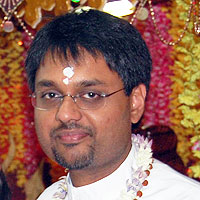From a satsang with Pt. Dr. Umesh Persad
To understand the Hindu worldview, we must understand that it declares that there is one Supreme and that all existence is Oneness. An analogy can be made that the Supreme is the ocean, and we are like the fishes in the ocean. The problem is that we identify as fish, when we are in fact the ocean. Similarly, we are like the clouds, and the sky is the Supreme. However, again, we identify with the clouds, which appear and disappear, and not with the eternal sky. When reading books, we also tend to identify with the printed word and not the unchanging page; at the cinema, we identify with the changing movie, the story and characters in the cinema and not the unchanging screen. Sanaatan Dharma urges us to identify with the unchanging eternal, permanent background and not the changing, transient reality of everyday life.
When we concentrate on the physical world, we look to Saraswati Devi, who personifies the concept of knowledge. Mahaa Saraswati, on the other hand, represents the Supreme Oneness of all creation. The essence of all striving after liberation and self realisation, is that realisation that everything is One. Usually, we just think of ourselves as individuals. However, we are much deeper than our thoughts and understanding about who we are. There is an interconnectedness between everything.
The origins of Saraswati Jayanti are explained in the Devi Mahaatmya, where Mahaa Saraswati emerged from the body of Gauri Maa to defeat the demons, Shumbh and Nishumbh, and their demonic henchmen. This battle represents the eternal, internal battle that exists within each of us from the day we are born until we are self-realised. Also referred to as Kaushiki Devi, she appeared with eight hands, holding eight items: a lotus, a bell, a trident, a plough, a sankh, a pestle, a discus and a bow and arrow.
To understand the depths of this scriptural episode, we can begin by analysing the meaning of the names: Kaushiki means ‘wrapped up in silk’ as well as “skilled and pure”. We can consider it from the perspective of a method or technique through which we can uncover the Divine within. We can return to our pure selves only after realising that we are all wrapped in silk, like fabric, interwoven with each other. Thus, everything is, in essence, one thing. The asuras that she conquered are all within our thoughts. Shumbh and Nishumbh represent the feeling of “I’ and ‘mine’. Like the duality of the world, they tend to come in pairs: sweet and sour; happiness and sorrow; life and death. The symbolic eight arms destroy the ashta pasha, the noose that binds us all. The subtle eight nooses are: hate, contempt or aversion; shame, fear, doubt, reproach, entitlement based on identity, attachment to and pride in a group based on activity or lineage; and good character which leads to pride. They require the subtle, sharp intellect of Mahaa Saraswati to discern their existence and eliminate them.



